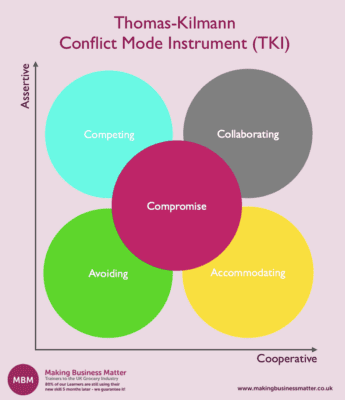The Essential Skillset We Can All Develop
Problem solving is a skill set that leaders, managers, and team members alike need in order to be effective. It’s crucial for navigating unexpected challenges and making everyday decisions. Things have been hard recently with COVID and then inflation, but businesses are surviving and thriving. Problem solving helps you take another look at a difficult situation and find a way through.
In this article, we look at the various skills involved in problem solving. From there, we consider strategies for different scenarios, including problems that appear so complex, it’s difficult to picture a solution. We explore problem solving in conflict resolution, management consulting and creativity, and end by looking at developing a problem-solving mindset. Which is something open to EVERYONE.
Why is Problem Solving So Important?
People with good problem-solving abilities stand out in a work team. But in difficult times, problem solving abilities don’t simply distinguish individuals as leadership material, ready and able to grasp opportunities. Problem-solving enables companies to be resilient and agile, pivoting into different ways of working and routes to market. And it allows them to adjust their course as conditions change.
What’s the Most Important Problem Solving Skill?
There isn’t just one! Problem solving involves a combination of skills, starting with critical thinking and analysis to understand problems and juggle possible solutions. Another aspect is being proactive, anticipating problems and acting to prevent them or mitigate their effects. Problem solvers are inclusive leaders, welcoming new ideas and taking inspiration from everyone. They’re also pragmatic, weighing up the factors that affect the choice of solution:
- Available resources – money, time, people.
- Deadlines that need to be met.
- Likely risks and rewards for each option.
Problem Solving is Part of Our Human Nature
Say the word ‘problem,’ and you might think first of a matter or situation that’s unwelcome or harmful. FIRE! It needs to be dealt with urgently, overcome, and put right. Problems can make us feel threatened and anxious. Our fight/flight reaction can stop us from thinking clearly about how to handle them. But calm yourself, and solving problems feels good.
We’re hardwired to problem solve, as evolved primates. Problem solving has this positive effect because it stimulates our brains to produce dopamine, the chemical regulating mood, memory, and concentration. There’s also extensive research linking the happy hormone, oxytocin, with collaboration, creative problem-solving, and being curious and acting on it. Work on developing your problem-solving skills, and you’ll feel better mentally and physically.

Sticky Learning ® is 7 times more effective than 1-day training courses. Plus, you will get a Chain of Evidence proving your Return on Investment. Discover soft skills training that changes behaviours long term.

3 Kinds of Problem Solvers – Which One Are You?
- Independent – Look at a problem and solve it on your own, right away.
- Thinker – Think critically about a situation before making a move.
- Asker – Ask someone else for the answer, to make sure you’re solving the problem the right way.
This is a trick question! The reality is, we all problem-solve in one or other of these ways, depending on the situation and our previous experience. When you’re in the hot seat in an interview, explain how you’ve used all three approaches, and you’ll do well.
What Makes a Good Problem Solver?
Good problem solvers make decisions and resolve issues using critical thinking and analytical skills. They consider all the factors in situations and decide the best solution. This includes finding solutions to seemingly insurmountable problems. Stay focused, break the jigsaw into smaller pieces and you’ll start seeing daylight.
What Are the Strategies for Problem Solving?
Whatever problems we face, work challenges, practical problems, or personal issues, people around the world tackle them the same way:
7 Steps in Problem Solving
#1: Define the problem
#2: Analyse the problem
#3: Develop potential solutions
#4: Evaluate the options
#5: Select the best one
#6: Implement the chosen solution
#7: Measure the results
To Solve a Problem, First You Must Be Clear What it is
Let’s look in more detail at step 1, Define the Problem. The software architect Peter Cripps describes 3 types of problem:
- Simple problems have a single cause, are well-defined and have a clear and unambiguous solution.
- Complex problems can have multiple causes, are difficult to understand and solving them can lead to other problems and unintended consequences.
- Wicked problems: The IT design theorists Horst Rittel and Melvin Webber coined this term in 1973. It describes problems that seem so complex, it’s difficult to picture a solution.

Rittel and Webber identified wicked problems as having these characteristics:
- Difficult to define.
- Hard to know when they’ve been solved.
- No clear right or wrong answer.
- Difficult to learn to solve them through experience.
- Each problem is unique.
- There are too many possible solutions to be able to choose the ‘right’ one.
Here Comes the Cavalry! ALL Types of Problems Benefit from a Systematic Approach to Solving Them
Our stress level can affect our ability to see a situation clearly. The 4 ‘S’ Method will help you stay focused on solving the problem. The people who devised it were prepping MBA students for management consultancy careers, but it’s straightforward enough to benefit everyone.
4 Basic Steps in Problem Solving: The 4 ‘S’ method
- State the problem: Work to understand it, then state exactly what it is.
- Structure the problem: Break it down into smaller parts.
- Solve the problem: Having separated the parts, analyse each one separately and address it.
- Sell the solution: If you can’t persuade others of your solution’s value and feasibility, you’ll never implement it! When selling it to others, explain your reasoning, but focus on the solution.
Three Types of Problems
People solve three types of business problem:
- Hypothesis-driven problems
- Issue-driven problems
- Creative challenges, including sales, marketing, and communications planning.
The 4 ‘S’ method works for all three types of problems, helping people think clearly and avoid being swamped by detail and emotion.

Now Let’s Get on With the Show
People writing about work and organisational problem-solving use management language like goals, root causes and action plans. But the process they describe follows the 7 steps in problem solving we mentioned earlier. The following list comes from an American university:
The 8-Step Problem Solving Process
#1: Define the problem.
#2: Clarify the problem.
#3: Define the goals.
#4: Identify the root cause.
#5: Develop an action plan.
#6: Execute the action plan.
#7: Evaluate the results.
#8: Continuously improve.
The additional step in this list, continuous improving, covers the issues that arise after solving a particular problem. Continuous improvement involves being proactive in anticipating further problems.
Make Problem Solving a Team Effort
Effective problem solving as a team involves having an environment where everyone can speak their mind and contribute freely. Helping team members gain confidence and experience in problem solving is a key part of developing people. Problem-solving abilities are connected to other soft skills, including:
- Analytical skills
- Innovative and creative thinking
- A lateral mindset
- Adaptability and flexibility
- Level-headedness
- Initiative
- Resilience
Along with this shortlist, here are some other development areas to work on with your team:
- Critical thinking
- Researching and making rational decisions
- Emotional intelligence
- Team building
- Good communication
- Attentive listening
Everybody’s Doing It – Problem-Solving in Everyday Business Life
Thankfully, problem-solving in business isn’t always about complex, or major, problems! But it still involves following the 7 steps and staying focused with the 4 ‘S’ method. Here are some common scenarios calling for problem solving and effective communication:
- Correcting a mistake at work.
- Overcoming a delay.
- Resolving an issue with a customer.
- Overcoming issues related to a limited budget.
- Navigating a scheduling problem or staffing shortage.
- Troubleshooting and resolving technical issues.
- Solving housekeeping problems involving money, customer billing, accounting, bookkeeping etc.
- Taking the initiative when a colleague overlooks or misses something important.
- Discussing a problem with your superior before it becomes potentially worse.
- Solving a safety issue or reporting it to someone who can solve it.
- Reducing or eliminating a company expense.
- Finding ways to make the company more profitable through new services or products, and pricing, promotion, and sales ideas.
- Changing how a process, team or task is organised to make it more efficient.
- Using creative thinking to come up with solutions you haven’t used before.
- Carrying out research to collect data and information to find new solutions.
- Finding a new piece of data or insight that can guide a company’s decisions or strategy better.
- Boosting the company or team’s performance by improving communication.
- Handling and resolving conflicts.
Problem Solving in a Conflict
The Thomas-Kilmann Conflict Resolution Model identifies five styles of conflict management people use in resolving conflicts:

- Competing
- Avoiding
- Accommodating
- Compromising
- Collaborating
The best strategy for handling and resolving conflicts is to seek a win-win solution through collaboration. We’ll now look at how people do this, first in management consultancy, then in solving creative problems.
Think Like the Consultants – Problem-Solving Mindsets for Uncertain Times
In September 2020 the McKinsey Quarterly ran a piece summarising their findings from decades of problem solving with leaders across business, non-profit and policy sectors. McKinsey concluded great problem solvers are made, not born. They learn to adopt an open and curious mindset and follow a systematic process for cracking even the most inscrutable problems. And they’re at their best in conditions of uncertainty.
McKinsey’s 6 Mutually Reinforcing Mindsets
- Be curious about every aspect of your problem: Our natural biases can make us ‘shut down’ the range of solutions too early. Better solutions come from being curious about the broader range of potential answers. So, put question marks behind your first-cut answers! Curiosity is the engine of creativity.
- Be an imperfectionist, with a high tolerance for ambiguity: Tolerate ambiguity, and stay humble. Challenge obvious solutions that imply certainty, and back your hunches. Embracing imperfection leads to more effective problem solving.
- Have a dragonfly view of the world, seen through multiple lenses: Think beyond the obvious. Often, a secret only unlocks itself when viewed from multiple perspectives.
- Pursue “occurrent” behaviour and restless experimenting: Don’t just go with what you think will happen, find out what REALLY occurs. And be prepared to experiment. You’ll generate fresh data and get insights others don’t have.
- The smartest people aren’t always in the room: Brainstorm with people outside your usual team. The wider the circle you draw on, the more novel and creative your solutions will be.
- Show and tell: McKinsey’s piece says the best problem solvers make the solution obvious. Be clear about the action that should flow from your findings. Express it visually, so you can debate and embrace the path to the answers. Present it emotionally as well as logically, and show why your preferred action offers a good balance between risk and reward. Spell out the risks of doing nothing at all, which could be costlier than solutions that aren’t quite right.
How To Solve Creative Challenges
The other important area of business problem-solving is creative challenges, including advertising, marketing, and communications.

- Balance divergent and convergent thinking: Think creatively to start with, then pick out the ideas that most closely fit the brief.
- Reframe problems as questions: Shift from seeing the obstacles to finding potential solutions.
- Defer judgement of ideas: There are no wrong answers or bad ideas in a brainstorm.
- Focus on “Yes and,” instead of “No, but”: Encourage everyone to feel involved in finding possible answers.
- Remember the 4 C’s of problem solving: Communication, collaboration, critical thinking and creativity.
Brainstorming, as in idea generation, involves the following steps:
- Clarify and identify the problem: WHY is there this problem? Set criteria for judging the ideas you generate.
- Research the problem: Use the available desk research and carry out consumer research.
- Identify the creative challenges: In what ways could we address this better?
- Generate the ideas: Write down everything people come up with. Don’t let anyone criticise anyone else’s ideas. And set a time limit.
- Evaluate the ideas: Do this against the criteria you set, and find which ones meet them most effectively. If you’re the team leader, don’t just pick your personal favourites! You may need to develop some ideas further, but it will be worth it.
- Draw up an action plan, and go for it.
And Finally: Developing A Problem-Solving Mindset
A problem-solving mindset is essential in business. Even with the best planning and preparation, things can go wrong. Focus on these critical aspects:
- Take responsibility: Avoidance isn’t a problem-solving skill! When you see a problem, be eager and willing to step up and try to resolve it.
- Take ownership of your emotions: When things go wrong, it’s important to centre yourself and regain your composure, before choosing your response.
- Be clear about what’s gone wrong, what it’s costing you and the goal you’d like to achieve.
- Stay objective: Be accurate and detailed about what’s happened, and don’t fill any gaps with assumptions.
- Listen actively: People will feel valued and appreciated, and encouraged to be more open, trustworthy, and helpful as you work to resolve the problem.
- Probe and reflect: Question and reflect, and gather as much information as you can.
- Seek to find the most appropriate solution: Don’t necessarily jump at the first solution that comes to mind. Invite all the stakeholders to offer their thoughts.
We Have The Technology. But We Still Need The Humans!

The World Economic Forum listed complex problem solving as the number one business skill for 2020. And McKinsey’s leadership group’s research shows organisations with problem solving capability in the top 25% earn 3.5 times higher shareholder return than the bottom 25%. Algorithms are transforming problem solving, but the reality is, combining them with human capability still gives better outcomes.
Yes, the tech can crunch through the data faster than we can, but it doesn’t necessarily come up with the obvious reasons behind it. Or the best solutions. Humans look set to remain essential in problem solving for the foreseeable future. And right now, it’s a skill set we can all develop.




